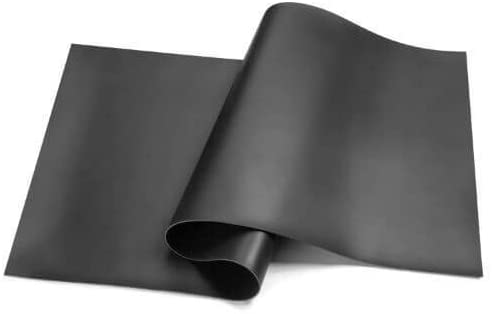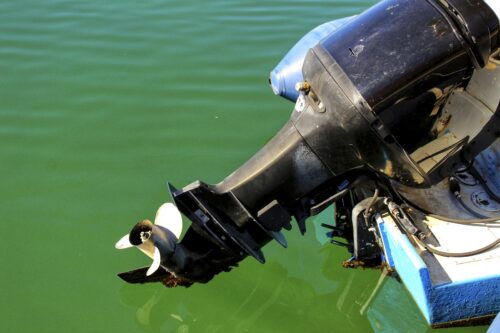Two-stroke outboard motors are loud–some over 100 decibels–louder than a belt sander or motorcycle. Not everyone appreciates having a quiet day on the water disturbed by the noise of a screaming motor behind them.
Here are a few ways to make your motor quieter. Which will make your fishing trip much more pleasant.
Note: You may be interested to know that 4 stroke motors produce about the same number of decibels, but at lower frequencies. Which makes them sound quieter. For more information on decibels and sones (the perceived noise something makes) please see our article Sones – Ratings and Charts.

What Makes 2 Stroke Engines so Loud?
The following is an animation of a 2-stroke engine showing fuel intake and exhaust from Wikipedia – Two-Stroke Engine.

Two-stroke engines do not have valves to regulate fuel/air intake. Or the elimination of exhaust gasses. The result is that 2 sound waves are created on each stroke. This results in a higher frequency making the 2-stroke sound louder than a 4-stroke engine. The decibel ratings for both types of engine is roughly the same.
Some automakers like Saab and Suzuki manufactured cars with 2-stroke engines until the 1980’s when pollution standards forced them to quit. An out-of-tune 2-stroke engine may cause more pollution due to the unburned oil fuel mixture in the exhaust. It will certainly be noisier.
Ways to Quiet Your 2-Stroke Outboard Motor
Most 2-stroke engines are very compact and light, making soundproofing inside the covers a bit of a challenge. And using anything outside of the motor can interfere with operation.
Outboard Motor Cowling Soundproofing
 Mass Loaded Vinyl
Mass Loaded Vinyl
Many outboard motor cowlings (the motor cover) come with insulation material inside. This will usually last about 10 years. And generally, is not very good at soundproofing. It is quite often soft foam glued on the inside of the cowling. The foam is much better at keeping the cowling relatively cool to the touch, than it is at soundproofing.
One of the absolute best options is automotive soundproofing such as Noico 80, Dynamat, Kilmat, or Hushmat. (Please see our article for more information by clicking on the highlighted names.) Another great choice is Mass Loaded Vinyl which has an STC rating of 23. Meaning that it can reduce noise by up to about 23 decibels. The advantage of automotive soundproofing products is that they are self-adhesive.
None of these products can be removed easily. They will almost surely leave a residue that will be difficult to get off. Because of this, you should be sure of your choices before installation.
Automotive Soundproofing
Automotive soundproofing is used to quiet engine compartment noise, road noise, speaker rattle, and other sounds that annoy you while driving. It is used everywhere in cars. Most of these products are very thin–around 1/8″ thick. They are self-adhesive and easy to cut. Most of them are black butyl-based products with reflective foil on the finish side.
Note: For more on quieting speaker rattle please see our article How to Fix Car Speaker Rattle.
After removing the cowling, scrape out any old insulation material. Clean off remaining foam and adhesive using paint thinner, or Goof-Off. Let dry. Measure and cut your soundproofing to fit. It can be butt-jointed to make a seamless fit. Peel the backing off and stick the pieces in place. Use a small roller (purchased with the material or one you have) to ensure good adhesion. (You do not want pieces falling onto a hot motor.) Make sure you leave all ventilation ports unobstructed.
Most automotive soundproofing products offer both a roller and seam tape. It is a good idea to have both. Some of the products mentioned have a “repositioning window” of 20 or 30 seconds–allowing you to get a perfect fit. Some of them–like my favorite Noico 80–have the same type of “repositioning window” as poop on a blanket. If you do not get it right the first time, you will need the seam tape.
Mass Loaded Vinyl
Before installing MLV to the inside of the cowling, clean off every bit of existing insulation and adhesive, using paint thinner or Goof-Off.
MLV is one of the best soundproofing materials on the market. The 1 lb. material is about 1/8″ thick, making it possible to fit inside the outboard cowling without interfering with motor operation. It is easy to cut to size, making for good fitting inside the cowling. Make sure to leave all ventilation ports unobstructed.
MLV is not self-adhesive. You will need to buy glue to install it. There are quite a few adhesives that work on vinyl, but given the heat and vibration of outboard motors, I would use contact cement. It can be a little finicky to work with–specially if you are new to the product. But once your MLV is on, it will stay there. Follow the directions on the can. Almost all contact cement is a one-time application. Product cannot be removed without a lot of effort and usually some chemicals.
Other Ways to Quiet Your 2-Stroke Engine
Making a 2-stroke outboard motor quiet is fairly difficult because of its compact design. Also because of the amount of access to the motor that you require. You need to start it, tilt it, hang onto the handle to control the motor and boat. All of this eliminates many types of soundproofing ideas, like small walls or baffles. Here are a few extra things you might try.
Outboard Motor Mounts
Most people think that only a high pitched noise comes from outboard motors. But another sound is as much feel as frequency. You can usually feel bass sounds as well as hear them. In a boat, vibrations are transferred from the motor through the mounts. If the mount is loose in any way, it will vibrate against the hull, adding more noise.
Note: It may also vibrate off, enabling your motor to sleep with the fishes.
All outboard motor mounts are fairly skookum pieces of equipment. They have to be. You are hanging a heavy dead weight off the back of a boat with a few bolts. Tilting it when necessary, and pivoting the motor for steering. Not to mention the torque of changing speeds.
Most mounts are metal without any anti vibration padding. Motor mount pads are usually available from marine supply companies or online suppliers. They are made to match almost any mount configuration. You can also buy anti vibration pads that are easy to cut and fit.
Unless your motor mount pad is made for the mount you have, use thin anti vibration material. Anything over 1/2″ could cause bolt shear strength problems. Or vibrate loose easier.
Outboard Motor Exhaust
Most 2-stroke outboard engines exhaust through the propeller shaft. The exhaust also expels water that was used to cool both the motor and exhaust. All of the pipe is generally underwater, making the exhaust fairly quiet. In fact, many manufacturers advertise underwater exhaust systems by extolling how quiet they are.
I have seen some funky ABS pipe DIY muffler system that claims to quiet the exhaust some. But it is jury-rigged onto the end of the propeller shaft and sticks above the water. Seems like fixing a problem that does not exist. Also, rumor has it that the company making them is no longer in business.
Marine outboard dealerships might be able to help you with an outboard motor that exhausts above the water line. Keep in mind that most above water exhaust systems are for inboard motors, 4-stroke motors, or high performance motors. I am not aware of any type of above water exhaust system you can buy to quiet the thing down.
Quite likely every dealership will tell you not to wrap anything around the exhaust to make it quieter. There is very little room inside the housing and wrapping it with the wrong produce (not heat resistant) will be dangerous.
Additional Ways to Quiet a 2-Stroke Outboard Engine
Here are a few other ways to make your outboard quieter.
- Air Intake Silencer. 2-stroke air intakes can be quite noisy. If available, a silencer will help make yours quieter. Although Evinrude has been manufacturing these since 1976, many other companies still do not make them. You may have to do some searching to find one that works on your motor.
- Earplugs. Pretty simple. Inexpensive. Can help save your hearing.
- Noise Cancelling Earmuffs. Although you may feel a little uncomfortable wearing these, if they can provide some extra quiet, they are well worth it.
- RPM. Try your motor at different Revolutions Per Minute to try finding the sweet spot. You may find that 200 fewer RPM produce less decibels of noise without much difference in performance.
For more on earmuffs, please see our article The Best Noise Cancelling Ear Muffs for Sleeping of 2023.
See a Professional
Almost all marine motor mechanics and/or dealers will be able to quiet your motor. Some will use the same ideas listed on this page. Some will have their own pet noise cures. If you are not a DIY type, have the dealership do the work for you. If you are buying a new boat and motor, or just the motor, they will probably suggest some noise reduction to you.
How Not to Quiet Your Outboard Motor
You may have heard that it is a good idea to leave your cowling travel cover in place while the motor is running. NO! These covers are designed to prevent rock chips in the cowling while traveling. Or bird poop and other things while the boat and motor is sitting in the driveway. Leaving it on while the motor is running can restrict air intake. It can also cause overheating and in the worst-case scenario, the cover will cause a fire.
Do not use any soundproofing material that will cover the motor or the air intakes. Although 2-stroke engines are really tough, they are not indestructible.
Why Use 2-Stroke Engines?
Two-stroke engines are the preferred power source for many applications. Outboard motors, chain saws, weed whackers, any application where the following are design priorities.
- Mechanical Simplicity. Easy to maintain. Well maintained 2-stroke engines usually start and perform very consistently. A dead outboard motor while out in the middle of a big lake can be depressing.
- Light Weight. 2-stroke engines eliminate many of the extra parts needed by a 4-stroke engine, such as oil pan, valves, lifters, rods, etc. How much more fun would a weed whacker be if it weighed another 15 pounds?
- High Power to Weight Ratio. You want the chain saw to cut quick and not pull your arms out.
- Operate in any Orientation. Being able to efficiently use equipment at any angle has real advantages. Many 2-stroke engine applications will operate in virtually any position including upside down.

